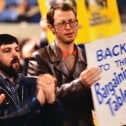1963 - 1972
In ten short years, CUPE united public sector workers. It made history. It influenced change. It became a force to be reckoned with.
CUPE was born out of ambitious plans in tumultuous times. The 60s were a time of change.
The National Union of Public Service Employees and the National Union of Public Employees merged in September 1963 at the founding convention in Winnipeg’s Fort Garry Hotel and launching the Canadian Union of Public Employees.
CUPE’s leaders were drawn from its founding unions: NUPE’s Robert Rintoul was elected Secretary-Treasurer. NUPSE’s Stan Little was elected president.
The new union’s first strike in 1964 was over the right for public utility workers in Perth Ontario to join the union.
In 1967, a series of innovative rotating strikes brought gains for 9,000 Hydro-Quebec workers.
In 1968, CUPE was the first union in North America to organize province-wide bargaining for schools and hospitals.
CUPE members were the first library workers to go on strike (1970) and the first police officers to go on legal strike (1971).
An early show of CUPE’s unity and power came in 1966, when nearly 2,000 members gathered at Ontario’s legislature to protest the government. They read a Bill of Wrongs, listing ten pieces of legislation that explicitly discriminated against public employees.
In the spring of 1972, 9,000 CUPE members joined hundreds of thousands of Quebec workers in the Common Front - a strike against the government that shut down the province.
Calls for women’s equality grew louder. A major breakthrough came in 1967 when CUPE 101 in London, Ontario did away with separate collective agreements for men and women.
In 1971, the union adopted the 9-Point Plan on women’s rights that would make CUPE a leader in the fight for equality throughout the 70s.



